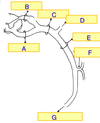LEC 7: Autonomic Nervous System - 08.20.2014 Flashcards
(56 cards)
What are the two basic fiber types in a spinal nerve
- Afferent fibers
- Efferent fibers
How many total Afferent and Efferent fibers are there
(2) Afferent Fibers
(2) Effernt Fibers
Total of (4) Fibers in a spinal nerve
What are General fibers
- Fibers that can be found anywhere in the body “from the nose to the toes”
- All fibers in spinal nerves are General fibers
NB: no “special” fibers in spinal nerves (cranial nerves only)
What are the four (4) fiber types
- General Somatic Afferent (GSA)
- General Somatic Efferent (GSE)
- General Visceral Afferent (GVA)
- General Visceral Efferent (GVE)
Label this drawing

Dorsal Root Ganglion (DRG), which contains Afferent Sensory Fibers
- Cell Body of General Somatic Afferent Fiber
* takes sensation (sensory) from body walls - Cell Body of General Visceral Afferent Fiber
* takes sensation (sensory) from inside organs
referred pain
- pain perceived somewhere in body, other than at/from the source of irritation
- e.g. heart pain felt/perceived in left arm
- basis of referred pain is that somatic/visceral bodies lie in same root
The Autonomic Nervous System
The peripheral nervous system (PNS) is divided into two (2) branches:
- Somatic System - dervies from somites, innervates skeletal muscle and skin
- Autonomic System - innervates smooth muscle, cardiac muscle, glands
NB: As opposed to CNS (brain and spinal cord), the PNS is composed of all the nerves/ganglia that communicate with CNS.
What does the somatic branch of the peripheral nervous system innervate
skeletal muscle and skin; dervied from “somites”
What does the autonomic branch of the peripheral nervous system innervate
smooth muscle, cardiac muscle, glands
Which fibers make up the autonomic nervous system (ANS)
General Visceral Efferent (GVE) Fibers
How many neurons are relayed in the ANS
the ANS is a 2 (neuron) motor system
What does the ANS control
- feeding
- fighting
- fleeing
- sex
NB: it innervates the visceral structures
viscus, viscera
- viscus* (singular, Latin) “hollow organ”
- viscera* (plural, Latin) for “internal organs”
What does the ANS innervate
visceral structures made up of:
- smooth muscle (e.g. eye, bladder, erectile tissue, gastrointestinal tract, arrector pili, blood vessels)
- **cardiac muscle **(heart)
- **glands **(e.g.sweat, salivary, lacrimal, adrenal, liver)
arrector pili
small muscles attached to hair follicles in mammals; contraction of these muscles causes the hairs to stand on end “goose bumps”
lacrimal glands
tear glands
Is the ANS motor or sensory
(by our definition) the ANS is purely motor (efferent); there is not a sensory part of the ANS by this definition
NB: true that there is an afferent (sensory) trigger, carried by General Visceral Afferent (GVA) fibers, but by our definition GVA is **NOT **part of the ANS
Remember:
Afferent = sensory = dorsal root ganglion
Efferent = motor = ventral root
How many motorneurons are involved in the ANS
Two (2) motorneurons

splanchnon
splanchnon (Greek, singular) “hollow organ”
Describe the two (2) motorneuron relay in the ANS
- (2) General Visceral Efferent (GVE) fibers
- 1st neuron = preganglionic neuron (presynaptic)
- nucleus (initial cell body) in brain stem
- axon = myelinated
- Neurotransmitter = acetylcholine
- 2nd neuron = postganglionic neuron (postsynaptic)
- ganglion (cell body) receives signal from 1st
- axon = unmyelinated
- effector (target) = smooth muscle, cardiac muscle, glands
nucleus and tract
- nucleus = nerve cell bodies (somas) found WITHIN the CNS (brain and spinal cord)
- tract = nerve cell processes (axons/fibers) found WITHIN the CNS (brain and spinal cord)
ganglion and nerve
- ganglion = nerve cell bodies (somas) found OUTSIDE the CNS
- nerve = nerve cell processes (axons/fibers) found OUTSIDE the CNS
How are anatomical subdivisions of ANS determined
By location (either brain or spinal cord of first (preganglionic) cell bodies
NB: cell bodies of preganglionic nerves (1st nerves) also called nuclei
What are the two (2) subdivisions of the ANS
- sympathetic nervous system
* thoracolumbar (inital cell bodies are in T/L portion of spinal cord) - parasympathetic nervous system
* craniosacral (initial cell bodies are in S portion of spinal cord or in brain stem)















